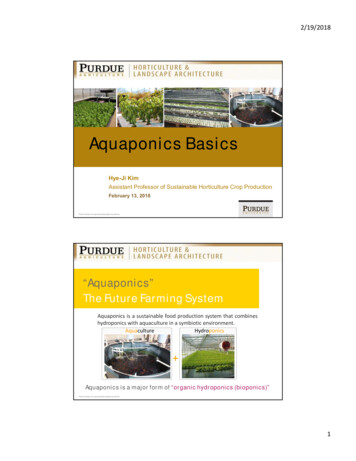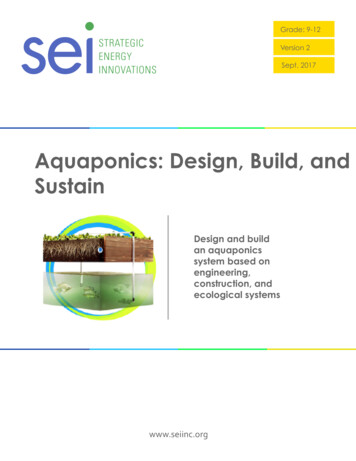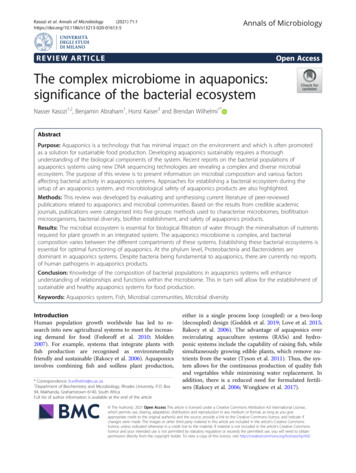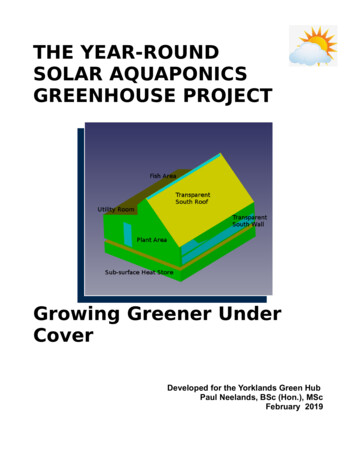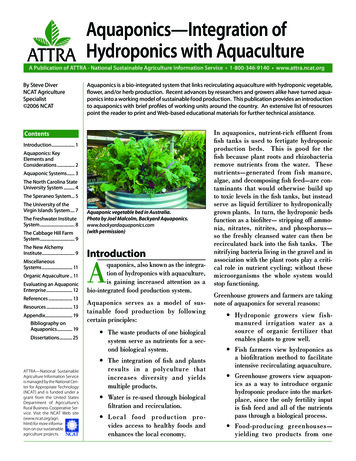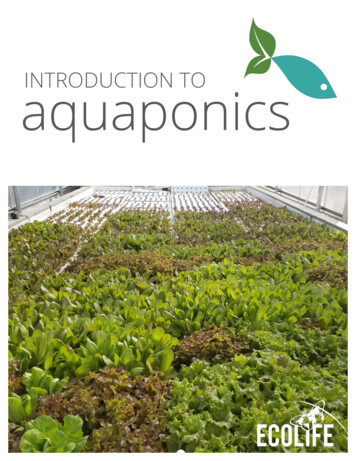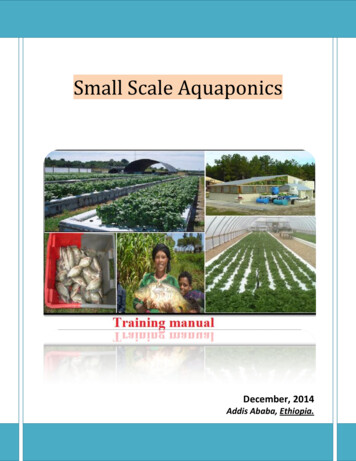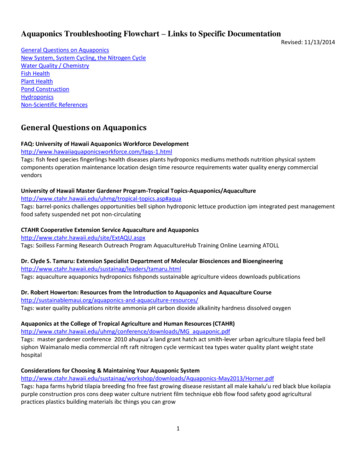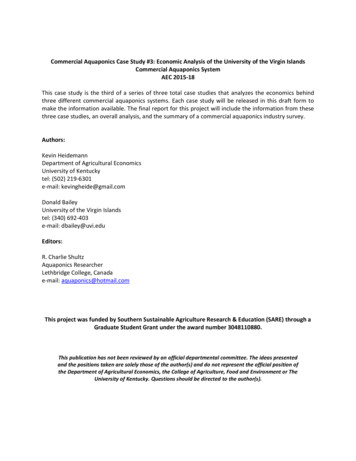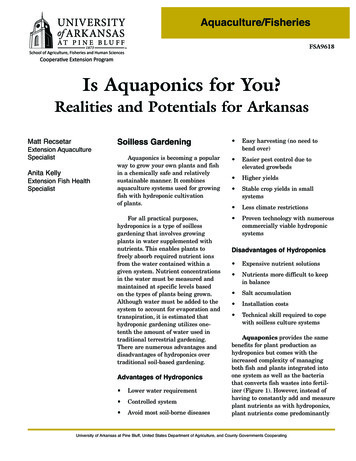
Transcription
Aquaculture/FisheriesFSA9618Is Aquaponics for You?Realities and Potentials for ArkansasMatt RecsetarExtension AquacultureSpecialistAnita KellyExtension Fish HealthSpecialistSoilless Gardening Easy harvesting (no need tobend over)Aquaponics is becoming a popularway to grow your own plants and fishin a chemically safe and relativelysustainable manner. It combinesaquaculture systems used for growingfish with hydroponic cultivationof plants. Easier pest control due toelevated growbeds Higher yields Stable crop yields in smallsystems Less climate restrictionsFor all practical purposes,hydroponics is a type of soillessgardening that involves growingplants in water supplemented withnutrients. This enables plants tofreely absorb required nutrient ionsfrom the water contained within agiven system. Nutrient concentrationsin the water must be measured andmaintained at specific levels basedon the types of plants being grown.Although water must be added to thesystem to account for evaporation andtranspiration, it is estimated thathydroponic gardening utilizes one tenth the amount of water used intraditional terrestrial gardening.There are numerous advantages anddisadvantages of hydroponics overtraditional soil based gardening. Proven technology with numerouscommercially viable hydroponicsystemsAdvantages of Hydroponics Lower water requirement Controlled system Avoid most soil borne diseasesDisadvantages of Hydroponics Expensive nutrient solutions Nutrients more difficult to keepin balance Salt accumulation Installation costs Technical skill required to copewith soilless culture systemsAquaponics provides the samebenefits for plant production ashydroponics but comes with theincreased complexity of managingboth fish and plants integrated intoone system as well as the bacteriathat converts fish wastes into fertil izer (Figure 1). However, instead ofhaving to constantly add and measureplant nutrients as with hydroponics,plant nutrients come predominantlyUniversity of Arkansas at Pine Bluff, United States Department of Agriculture, and County Governments Cooperating
dechlorinate the waterbefore stocking fish and anytime water is added to thesystem. Chlorine used inmunicipal water will killyour fish.Figure 11Figurefrom the fish production tank. In appropriatelydesigned aquaponic systems, fish provide adequatenutrients for the plants.Things to ConsiderWhen Caring for FishCaring for fish in an aquaponic system addsconsiderable complexity to an indoor gardeningsystem. The following are key questions that shouldbe considered carefully before investing in anaquaponic system: Do you have the time to care for fish? Fish needto be fed every day, so if you plan on going out oftown for a week, you will need someone to feedand maintain fish while you are gone. What will you do if you lose power? Fish requiregood water quality which includes adequateoxygen levels and minimal nitrogen levels. If youare not around and the power goes out, you risklosing fish due to lack of oxygen from aerationand filtration. Even if fish do not die during apower outage, they may become more stressed,which can lead to disease outbreaks. What is your water source? Use only well water,uncontaminated rain water or treated municipalwater. If municipal water is used, you will need to What can be done if thefish get sick? It is impera tive that the disease bediagnosed and treated.Unfortunately, most treat ments for fish diseases arenot safe for plants. You willneed to have a separatetreatment tank or a methodto make sure the plants arenot exposed to the treat ment required by the fish.Three Types of Aquaponic SystemsThere are three main types of aquaponic systemswith different advantages and disadvantages(Table 1). Some types are more suitable for backyardor small scale systems while others work best forlarge commercial hydroponic systems.Floating Raft (Deep Water Culture) SystemsThe floating raft system (Figure 2) involvesgrowing plants supported by polystyrene (or similar)rafts that float on top of a relatively deep (12 24 inch)water trough. The plants are supported by the raftsFigure 2. Floating Raft System
while their roots are directly submerged in thenutrient rich water below. Floating raft systemsare generally used in commercial aquaponics forproduction of herbs and leafy greens.NFT Systemscommercial systems for production of herbs and leafygreens, although individuals have utilized this designto maximize space at home.Flood and Drain SystemsThe nutrient film technique (NFT) (Figure 3)involves a trickling or low flow of nutrient rich waterdown an inclined pipe or gutter. The plant roots hangdown and draw up nutrients as needed from the filmof water while still allowing for a portion of the rootsto be aerated. NFT systems are commonly used inFlood and drain systems (Figure 4) involve grow ing plants in a media filled growbed that regularlyfills and drains with nutrient rich water. The ebb andflow of water in the growbed allows for root aerationand helps prevent anaerobic conditions that mightotherwise occur. The flood and drain system is usedfrequently for home based aquaponics.Figure 3. NFT SystemFigure 4. Flood and Drain SystemTable 1. Choosing the Right SystemSystem TypeFloating Raft(Deep Water Culture)NFT SystemFlood and Drain(Ebb and Flow)––––––––ProsEasy plant rotationGreat for lettuce and herbsCan withstand power outagesMost resistant to temperature andpH fluctuationsGreat for herbs and leafy greensCan utilize limited spaceAllows for root aerationFish and plants can be decoupled– Can grow almost anything– Growing media acts as biofilter andmechanical filter– Allows for most intense plantspacing– Simple designCons– Limited to herbs and leafy greens– More aeration needed– Need separate biofilter– Plants will die quickly if pump clogsor stops functioning– Need separate biofilter andsolids removal– Water temperature fluctuations– Bell siphon required (can be tricky)– Media can be expensive– Pump more likely to clog (in fish tank)
Growing StrategiesThe climate in Arkansas ranges from hot andhumid in the summer to cold and snowy in thewinter. The typical growing season for most fish andplants ranges from April to October but will do bestwith increased sunlight and temperatures above65 F. Before investing in aquaponics, you will needto decide on a growing strategy. Grow indoors – Can grow crops year round, willneed UV grow lights. Important to consider waterspillage if you are choosing this option. Grow outdoors – Generally you can grow cropsfrom May to September, so will have to eithershut down in the winter or bring the systemindoors. This is the most common strategy forsmall scale aquaponics and likely the lowestcost as you do not need to purchase grow lightsor a greenhouse if you plan on shutting down inthe winter. Grow in a greenhouse – Without heating thegreenhouse, the growing season is from Marchuntil December. With some heat, plants and fishmay be able to survive through the winter butwill not grow as quickly without additional light.Without additional heat or light, how muchslower they grow depends on the plants and fishspecies in the system as well.Backyard AquaponicsSize of your system is another importantconsideration when setting up an aquaponic system.The larger the system, the more time and effort itwill require to maintain.Small scale or backyard aquaponics is a greatway to produce your own food and also serves as auseful learning tool for schools and communities.Investments can range from 100 if you are usinga 10 gallon aquarium to grow herbs to well over 50,000 if you buy a greenhouse, depending on thesize of the system and the materials used to build it.Typically you can save over 50 percent of the cost ifyou build it yourself.While having an additional crop with fish canseem like a good idea, this isn’t always enough tooffset the large cost associated with adding the aqua culture component. Tanks, plumbing and fish feed areall large costs, plus there is added risk created by thefish. The fish themselves will require additional care,so hydroponics may be a better alternative for indi viduals who do not have time every day to feed andcare for their fish.HarvestingFish and plants need to be harvested from yoursystem to maintain balance. Some plants can over grow your system and so need to be continuouslypruned and harvested. Some leafy greens grow bitterif left in your system too long, while fruits can go badif left to overripen. Techniques and strategies fromtraditional gardening should be applied where neces sary. Edible fish should be harvested once they reachmarket size and replaced as needed.Food SafetyFood safety is another important concern foraquaponic gardens. Food borne illnesses are a majorissue, so it is important to take steps to reduce possi ble contamination of your produce. Proper hygieneshould be practiced, and hands should be washedprior to touching any plants. Any time produce isharvested, latex, rubber or nitrile gloves should beworn, and every effort should be made to avoid con tact between the produce and the growing media.Storage facilities and containers should be kept cleanand surfaces that will come in contact with produceshould be sterile.Other Considerations Do you have adequate space available for use,and at what cost? Do you have a well? Well water generally hashigher alkalinity than municipal water whichhelps stabilize the pH of your system. This canbe a potential benefit to you and your plants.
Choosing FishYou will need to obtain an Arkansas fishfarmer permit from the Arkansas Game and FishCommission (AGFC) if you plan to sell your fish.It is a good idea to make sure the fish you plan togrow is on the Approved Aquaculture Species List oryou will need to apply for a restricted species posses sion permit or unlisted aquaculture species permitfrom AGFC.Table 2. Best Choice Fish (Easiest to Care for and Manage)Goldfish (or Koi)Golden ShinersFathead MinnowsHybrid BluegillTilapiaWhy Choose?ConsiderationsHardy fish with many sizes and colorsavailable. They also do not require anexpensive feed.Will eat plant roots if culturing in same tankas plants.Commercially available in Arkansas andgrow very well in tanks. Tasty and hardypan fish that will accept cheap commercialfeeds and grow big enough to warranteating.Best when stocked at high numbers toavoid aggression. Also must be fedregularly.Readily available in Arkansas and perfectfor maintaining supply of baitfish if you arean avid fisherman. Great for stocking smallsystems and will consume cheap commer cial feeds readily.Not edible.Tasty and hardy fish that will filter feed aswell as consume cheap commercial feeds.Cold intolerant (will not survive winterswithout tank being heated). Will readilyreproduce in tanks even before growing toedible size.Table 3. Other Fish Options (Require More Care and Management)Why Choose?Rainbow TroutTasty fish; will readily accept commercialfeeds; grow rapidly.Largemouth BassTasty fish; commercially available inArkansas.Hybrid Striped BassTasty fish; commercially available inArkansas.CrawfishTasty; can be used for bait; commerciallyavailable in Arkansas.Freshwater ShrimpTasty.*Territorial animals exhibit cannibalism.ConsiderationsRequire cooler water (winter option); highprotein feed required (more expensive);higher oxygen levels required; onlyavailable seasonally.Do better when crowded; high protein feedrequired (more expensive); produce largersolid wastes.High protein feed required (moreexpensive); more sensitive to changesin temperature and water quality.Can reproduce in tanks which willallow them to invade the entire system;territorial.*Territorial*; expensive; cold intolerant(below 65 F); poor availability.
Selecting Which Crops to GrowMany crops that growwell in Arkansas can likelybe grown in an aquaponicsystem. Your options changeif you are using a green house or indoor system.Some plants grow fasterthan others, while someplants require more workand maintenance thanothers. Also, some plantsare available as transplantswhile others are availableonly as seeds. If you do notwant to bother with seeds,then your options will bemore limited, but successwill be visible sooner. Plantsshould be chosen based onindividual preferences andthe system being used. Itis important to keep inmind that an ebb and flowaquaponic system providesthe most options. A planthardiness map for Arkansasis shown in Figure 5.Figure 5.Plant Hardiness Zone Mapfor ArkansasThe University of Arkansas at Pine Bluff is fully accredited by The Higher Learning Commission,230 South LaSalle Street, Suite 7 500, Chicago, IL 60604, 1 800 621 7440/FAX: 312 263 7462.Printed by University of Arkansas Cooperative Extension Service Printing Services.MATT RECSETAR is an Extension aquaculture specialist andANITA KELLY is an Extension fish health specialist with the1890 Cooperative Extension Program at the University of Arkansasat Pine Bluff.FSA9618 PD 9 2015NIssued in furtherance of Extension work, Act of September 29, 1977, incooperation with the U.S. Department of Agriculture, Dr. Edmund R.Buckner, interim dean/director, 1890 Research and Extension Programs,Cooperative Extension Program, University of Arkansas at Pine Bluff.The University of Arkansas at Pine Bluff School of Agriculture, Fisheriesand Human Sciences offers its programs to all eligible persons regardlessof race, color, sex, gender identity, sexual orientation, national origin,religion, age, disability, marital or veteran status, genetic information, orany other legally protected status, and is an Affirmative Action/EqualOpportunity Employer.
Three Types of Aquaponic Systems There are three main types of aquaponic systems with different advantages and disadvantages (Table 1). Some types are more suitable for backyard or small scale systems while
